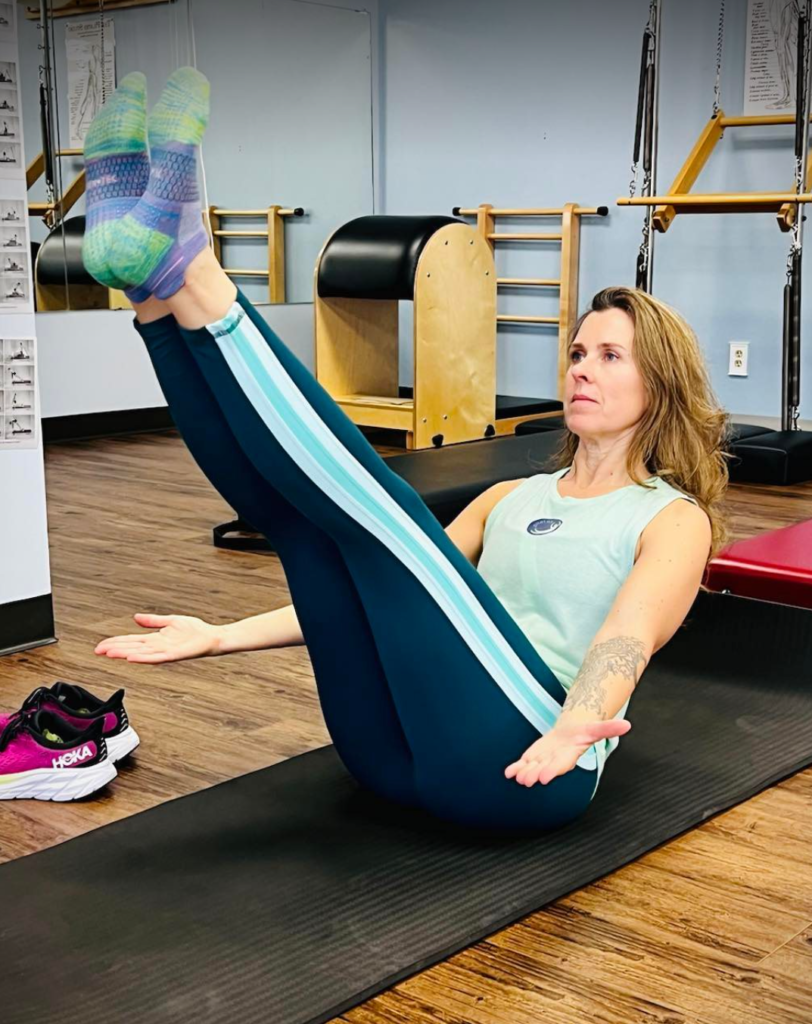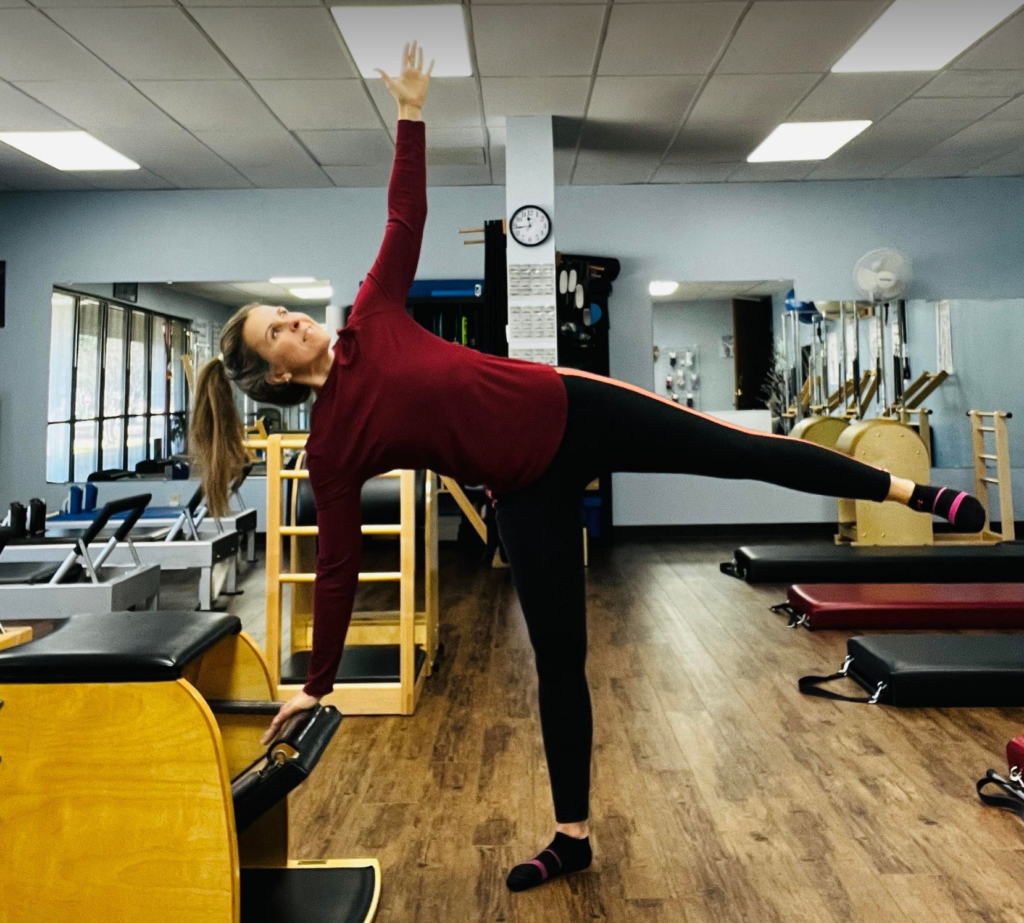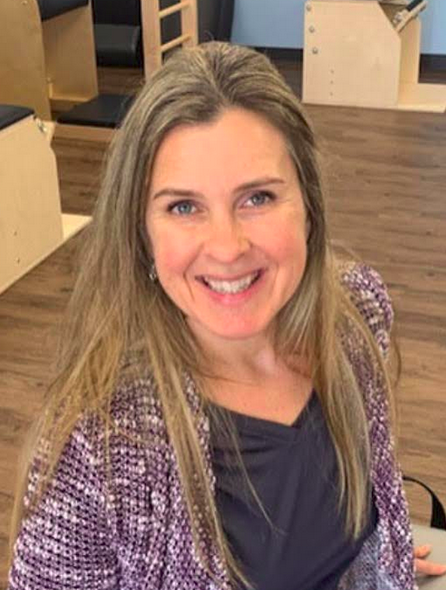Issue #393 – Wednesday, March 1, 2023
How Pilates Changed My Yoga Practice
by Tricia Whitlock
I attended my first yoga class at the age of 24 with the goal of finding an activity that made me flexible, lean and strong. At that time, I had never heard of Pilates. Yoga was foreign to me, and I remember feeling nervous, excited and having absolutely no clue what to do. The instructor was friendly, spunky, and had that special ability to make you feel seen, even in a large group. I became addicted and it quickly became a wonderful, cozy habit 3 to 5 days a week. I enjoyed the meditative, calming aspect; it was a much needed relaxation at a time when I worked in a busy, corporate position.
Yoga advertised its ability to help build strength, tone muscles, ease stress, and increase flexibility. Yet my body remained thicker than I wanted. I was unable to achieve boat pose for more than a few seconds. My spine resisted deep twisting (but I did it anyway) and I often suffered from sciatica. My aches and pains persisted, and it seemed that my core muscles napped while the rest of my body compensated.
Fast forward fifteen years. At age 39, I took a hard look at my fitness. Despite years of yoga practice, I still could not hold boat pose with any semblance of stability or stamina, I was still thick in the thighs (admittedly this was a bit of dysmorphia), and the sciatic pain was sometimes unbearable, causing me to drag my leg behind me when walking.
Then I discovered Pilates.
From the first class, I was hooked. The cues, movements, and philosophy were completely different. I was able to focus, concentrate, and learn in a way that made sense to my logic-driven mind. Soon I began to see changes in my body – definition, tone, and a half an inch on the yardstick! After about a year, the sciatic pain had mostly vanished.
What was so different about Pilates? In my experience, here are 3 things that stand out:

The 2-way stretch
The reformer and other interesting apparatus used in Pilates provided my mind and body with much needed feedback on where I should be in space, exactly how deeply my body was “correctly” able to twist and bend, and how to find length in those movements, rather than collapsing. Jay Grimes refers to this as “the 2 way stretch”, and this concept, when applied to my yoga practice, allowed for much more ease and efficiency in movements that I previously strained and struggled through. I learned how to stabilize … and that stability supported my limbs.
Proprioception
Dictionary.com defines proprioception as “perception governed by proprioceptors, as awareness of the position of one’s body”. Essentially, it is us asking “Where is my body in space?”
The apparatus (including the raised mat) gave this invaluable feedback through its various shapes, sizes and resistance options. Hands-on teaching reinforced the feedback and, with that combination, there was a cognitive leap forward that never happened for me in yoga. In addition, I was accustomed to yoga instructors doing the class along with their students. Having instructors provide feedback and cueing with touch rather than just relying on watching the instructor gave my mind and body incredible amounts of new information and catered to my own predominantly touch- and hearing-driven kinesthetic learning style. This dynamic combination taught me more about my body in 6 months than I’d learned during years of yoga.
A Deeper Knowledge and Understanding of how to listen to my body
“Am I doing this right?” is a question I often asked myself when working out. Looking back, my biggest challenge was plank. Plank, the exercise that appears in nearly every fitness modality, is hailed by some as the very best exercise you can do.
I hated plank.
The reason I hated it is because it felt so wrong, and often hurt (in all the wrong places).
Pilates and the concept of “lifting” allowed me to fall in love with plank.
These “lifting” and “2 way stretch” concepts were key for me in changing the way my body looked, felt, and responded.
I no longer wonder “Am I doing this right?” Instead, I can feel my way into “right”, with the understanding that it varies from day to day, as well as from one apparatus to another.
In Pilates, I learned to feel what my body needed by understanding those and other principles and building upon them. I was given the tools to be my own best teacher through this disciplined, logical method.
A return to yoga
One day I decided to drop in on a yoga class. I was open-mouthed astounded as my body floated up into a boat pose and I sat there holding it with grace and ease. My breath flowed and my mind was calm. I felt immense gratitude for all that the Pilates method had taught me, and even more gratitude for the role that yoga played in the journey. Yoga once again became a part of my life, but in a new and different way. Rather than battling my body and forcing it, I was truly at home and at ease with it.
Our bodies speak to us through pain and pleasure. I learned how to hear when my body whispered “YES” and when it firmly said “NO”. Not only listen, but respect. For when they are in harmony, mind and body truly can do amazing things.
Over my years as a Pilates student and teacher, I learned about how and why my body does the things it does, and how to make it move in a way that feels glorious. How to be long, tall, graceful, and strong in all the things I do, in and out of the studio. Because isn’t that why we exercise? Life is a celebration of movement. Yoga started me on that journey and for that I will be forever grateful.
Tricia Whitlock, NCPT is the owner of Soul Body Works, a boutique Pilates studio in north Texas. She began her Pilates journey at the age of 42, having worked in corporate America for most of her adult life, transitioning into fitness after the untimely death of her mother changed her perspective on life. Discovering Pilates changed Tricia’s life in many ways – not only did it provide the fuel for her entrepreneurial spirit, it healed her body from many years of chronic infections, sciatica and lower back pain, as well as giving her the fluid, graceful ability to move that she had always desired. Tricia has a big heart for Pilates studio owners and instructors, and is the co-founder of PlankeApp, which uses technology to help instructors and studios connect and fill temporary, substitute, and permanent teaching jobs around the world.
Tricia enjoys travel, creating art, reading science fiction, and hiking. You can learn more at www.plankeapp.com. Information about Tricia’s studio can be find at www.soulbodyworks.com



